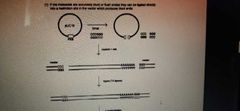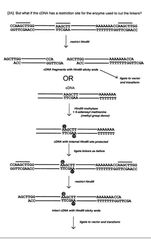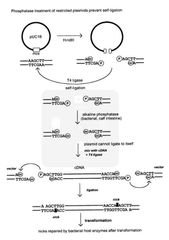![]()
![]()
![]()
Use LEFT and RIGHT arrow keys to navigate between flashcards;
Use UP and DOWN arrow keys to flip the card;
H to show hint;
A reads text to speech;
39 Cards in this Set
- Front
- Back
|
Requirements of cDNA synthesis |
4 deoxynucleotide triphosphates, magnesium ions and at neutral pH, |
|
|
cDNA requires to be converted into a double stranded DNA by |
DNA polymerase - DNA Pol I (Klenow fragment). This is the large fragment (75kDa) of DNA polymerase |
|
|
DNA polymerase I undergoes proteolysis with enzyme |
subtilisin; the resulting enzyme has 5'-3' polymerase activity and 3'-5' exonuclease activity but has lost the 5'-3' exonuclease activity associated |
|
|
Klenow enzyme uses |
Klenow enzyme is a truncated pol A gene cloned and expressed in E.coli. Klenow polymerase is used to avoid degradation of the newly synthesised cDNAs. To produce the template for the polymerase the mRNA must be removed from the ss cDNA:mRNA hybrid. |
|
|
Traditional cDNA synthesis (self-priming method) consists of |
1. Denaturation of cDNA:mRNA hybrid by boiling otr hydrolizing with OH- 2.Formation of hairpin loop at the 3' OH 3. Addition of dATP, dTTP, dGTP, dCTP 4. Addition of Klenow fragment from E.Coli, DNA polymerase 1(5' >3' exonuclease activity), Mg++ 5. Formation of ds cDNA 6. Hairpin loop is digested by S1 nuclease leading to formation of ds cDNA. |
|
|
cDNA synthesis by RNAseH method/ replacement synthesis of dsDNA |
1. Nucleotides (dATP, dCTP, dGTP, dTTP) are added in for cDNA synthesis. 2.ribonuclease ( RNase H ) which recognises the RNA component of a DNA:RNA hybrid and cleaves the RNA at a number of non-specific sites leaving short oligoribonucleotides attached to the cDNA. 3. These serve as primers for the polymerase to synthesise the second strand cDNA; DNA Pol I (not Klenow) is used since the 5'-3' exonuclease activity is needed to remove RNA in front of the enzyme. 4. The newly synthesised strands of cDNA are joined by ligation using bacteriophage T4 ligase . |
|
|
Restriction sites or cohesive ends in cDNA are incorporated by |
1. cDNA's resulting from self- priming method or RNA replacement method, have no specific ends (ie restriction sites or sticky ends) they sometimes need to be manipulated for efficient joining to a vector DNA molecule. 2. If the cDNA's are blunt-ended they may be cloned directly into a vector which has been cut with any blunt end cutting restriction enzyme such as Sma I. 3.Blunt-end ligations are usually much less efficient than sticky end ligations and so it is usual to provide cDNA's with cohesive ends. |
|
|
Sma1 enzyme recognises |

CCC^GGG sequence in the given cDNA where it is ligated directly into the vectors to produce blunt ends |
|
|
How to prevent internal cleaving of cDNA during restriction digestion |

Pretreatment of cDNA by methyltransferase of restriction enzyme used can be used to methylate cDNA(methylation activity), specific to restriction sites. |
|
|
How to prevent self ligation |

1. To prevent an unwanted ligation is, to remove the 5' phosphate group from the ends - ligation requires a 5' phosphate group and a 3' hydroxyl group on the ends of the compatible DNA fragments. 2. The enzyme used for this is alkaline phosphatase from bacterial sources or calf intestines. Once treated DNA fragments (eg plasmid) cannot ligate back together. 3. In cDNA cloning this means that ligation can only take place between the plasmid and a cDNA - only a recombinant plasmid is produced (ie one containing an insert). Second method is by using terminal transferase; 1.Leads to addition of homopolymer tails to 3' ends of the strand. In the presence of single base nucleotide (dCTP), enzyme builds up a string of poly C tail. 2. When restriction enzyme Pst1 is used with compactable poly C and poly G allows annealing of the insert and the vector respectively. |
|
|
Components of Extraction buffer and their function |
Extraction buffer= EDTA+SDS EDTA(Ethylene diamine tetra acetic acid)- helps in chelation and dissociation of Mg+2 ions from the cell . Mg+2 ions maintain the stability of the cell SDS(Sodium dodecyl sulphate) removes the lipids from the cell membrane disrupting the cell structure. |
|
|
Protein and rna is removed from the dna by |
For protein, organic solvents like phenol:choloroform extract (1:1) ratio is added for the precipitation of proteins. Forming an organic layer of proteins, leaving the nucleic acids in th2 aqueous phase. For the RNA, RNase is used to degrade the rna from the DNA extract. |
|
|
DNA Extraction is finally done by using |
Absolute Ethanol at -20C precipitates polymeric nucleic acids, which is then removed by spooling (adherent DNA strands) and by centrifugation (dissolved nucleic acids) |
|
|
Absorbance to measure DNA |
260nm (UV ) Absorbance = 1.0 |
|
|
Ratio of DNA in pure sample |
A260/A280= 1.8 |
|
|
Ratio of DNA extract conc. With protein/phenol contamination |
A260/A280= less than 1.8 |
|
|
Ratio of DNA extract conc.with RNA contamination |
A260/A280= more than 1.8 |
|
|
Ionic strength of DNA is improved by |
Addition of sodium acetate in ethanol precipitation |
|
|
Why is chemical synthesis of DNA also named as phosphoramitide method |
The 5' end of the strand is linked to DMT, to prevent side reactions (methylation, acetylation etc;) hence the name |
|
|
Full form of DMT |
DiMethoTrityl |
|
|
CGP fullform |
Control pore glass (macrostyrene bead) |
|
|
How is the DNA protected in initial step of phosphoramitide method |
The spacer molecule protects the nitrogenous base of the DNA |
|
|
What is the size of the nucleotide sequence in phosphoramitide method |
60- 80 bp |
|
|
Chemicals added to protect the nucleotide in phosphoramitide method |
DMT (5' end)+ DIPA (3' end)+ CH3 groups |
|
|
Chemical that protects 3' end of phosphoramitide method |
Beta cyano ethyl (BCA) group protects 3'- P group along with CH3 group |
|
|
Explain detritylation process in detail (pt 1) |
Step 1: the nucleotide with spacer molecule is pumped into the column, which attached itself to the CpG (glass bead- solid support) Step 2: acetonitrile is added to 2qsh off the unbounded nucleotides and argon is then added to washoff the acetonitrile itself |
|
|
List of agents used in phosphoramitide method |
DMT to deactivate and block reactive 5'- P grp DIPA at 3'- end with beta cyano acetone (BCA) at 3' P grp along with CH3 grp Acetonitrile to washoff DMT in detritylation process (step1) , Argon to washoff acetonitrile present Tetrazole + successive nucleotide added to the column. Tetrazole activates phosphoramitide to form linkage between 3' and 5' end of the previous and successive nucleotide Acetonitrile and argon wash tetrazole successively Acetic anhydride and dimethyl aminophospate (DMAP), is used to capp the 5-P of the previous nucleotide forming acetic acid cap Step 7. Oxidation is done by addition of iodine to strengthen the phophodiester bond between two nucleotides |
|
|
Who discovered restriction enzymes |
Werner Arber – discovered restriction enzymes |
|
|
Who pioneered the application of restriction for the construction of genetic maps |
Daniel Nathans - pioneered the application of restriction for the construction of genetic maps |
|
|
Who showed that restriction enzyme cuts DNA in the middle of a specific sequence |
Hamilton Smith - showed that restriction enzyme cuts DNA in the middle of a specific sequence |
|
|
Length of eukaryotic ligase 1 |
85 to 125 kda |
|
|
Length of eukaryotic ligase 2 |
68kda |
|
|
Mechanism of ligation process |
• ATP, or NAD+, reacts with the ligase enzyme to form a covalent enzyme–AMP complex in which the AMP is linked to ε -amino group of a lysine residue in the active site of the enzyme through a phosphoamide bond. The AMP moiety activates the phosphate group at the 5´-end of the DNA molecule to be joined. It is called as the donor. • The final step is a nucleophilic attack by the 3´-hydroxyl group on this activated phosphorus atom which acts as the acceptor. A phosphodiester bond is formed and AMP is released. • The reaction is driven by the hydrolysis of the pyrophosphate released during the formation of the enzyme–adenylate complex. Two high-energy phosphate bonds are spent in forming a phosphodiester bond in the DNA backbone with ATP serving as energy source. |
|
|
Temp required to achieve ligation by T4 DNA ligase |
4C for 30 mins |
|
|
Error rate of dna polymerase 1 |
~1/10^9 |
|
|
Error rate of taq polymerase |
1 x 10^4 to 2.2 x10^5 |
|
|
Error rate of pfu |
1.5 x 10^6 |
|
|
Error rate of vent polymerase |
In between taq and pfu |
|
|
First cloning experiment was done by |
Boyer and Cohen ,and also found out antibiotic resistant genes expressed |

